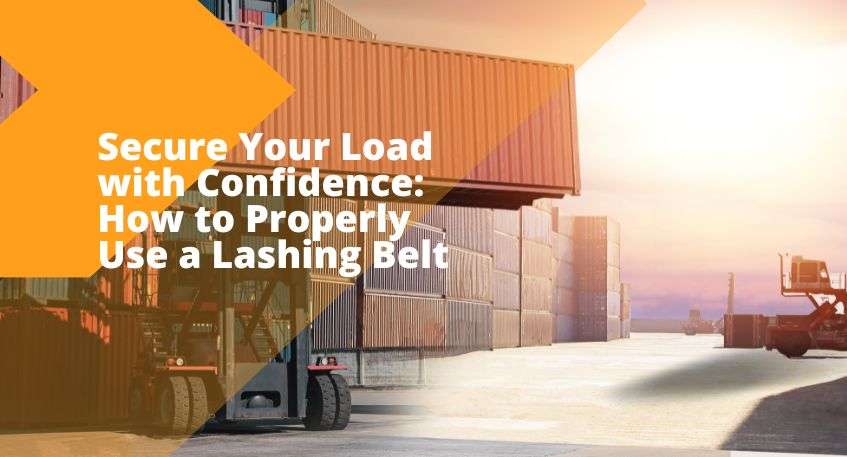
May 25,2023
When it comes to transporting goods or equipment, ensuring the safety and security of your load is of utmost importance. Improperly secured loads can lead to accidents, damage to the cargo, and potential harm to others on the road. That's where lashing belts come into play. Lashing belts, also known as tie-down straps or cargo straps, are reliable tools designed to secure loads and provide peace of mind during transportation. In this blog post, we will explore the proper usage of lashing belts and provide you with the knowledge to secure your load with confidence.
To start, let's define lashing belts. Lashing belts are flexible straps made from durable materials such as polyester or nylon webbing, equipped with various mechanisms such as ratchets or cam buckles. These belts are specifically designed to secure loads by providing tension and holding the cargo in place during transit. They come in different lengths, widths, and weight capacities to accommodate various load sizes and requirements.
Selecting the appropriate lashing belt is crucial to ensure the safe transportation of your load. Consider factors such as the weight of the cargo, the load's center of gravity, and the intended transport conditions. Be sure to choose a lashing belt that matches the weight capacity and load limits required for your specific application. Additionally, assess the quality and durability of the lashing belt, checking for wear, tear, or damage that could compromise its performance.
Before securing your load, conduct a thorough inspection of the cargo. Identify any potential risks or vulnerabilities, such as loose or protruding objects, and determine the securing requirements accordingly. Gather the necessary tools and equipment, including lashing belts, appropriate anchor points, and any additional accessories needed for a secure load. Plan and strategize the load-securing process, considering the size, shape, and weight distribution of the cargo.
Now, let's dive into the step-by-step process of using a lashing belt effectively:
Step 1: Position the load and prepare anchor points. Ensure the load is properly positioned and centered on the transporting vehicle. Identify suitable anchor points on the vehicle or cargo hold where the lashing belts can be securely attached.
Step 2: Attach and tension the lashing belt. Securely attach one end of the lashing belt to the anchor point, passing it over or around the load. Insert the loose end of the belt through the ratchet or cam buckle mechanism and begin tensioning by operating the ratchet or tightening the cam buckle.
Step 3: Securing additional anchor points if required. For larger or irregularly shaped loads, it may be necessary to secure additional anchor points. Repeat the attachment and tensioning process to ensure optimal load stability.
Step 4: Properly tighten and lock the lashing belt. Continue tightening the lashing belt until the load is firmly secured. Engage the locking mechanism on the ratchet or cam buckle to prevent any slippage during transit. Ensure the tension is evenly distributed along the length of the lashing belt.
Distribute the load evenly and minimize movement. Properly distribute the weight of the cargo to maintain balance and stability. Use dunnage or blocking materials to prevent shifting or sliding during transport.
Understand the angles and forces involved in load securing. Consider the forces that may act upon the load during transportation, such as acceleration, deceleration, or sideways movement. Account for these forces when tightening the lashing belts to maintain load integrity.
Double-check the tightness of lashing belts during transit. Periodically inspect and retighten the lashing belts if necessary to ensure they maintain proper tension throughout the journey.
Safety should always be a priority when using lashing belts. Adhere to the following tips and avoid these common mistakes:
Use appropriate personal protective equipment (PPE). Wear gloves and safety goggles when handling lashing belts to protect against potential injuries.
Avoid common mistakes when using lashing belts, such as inadequate tensioning, using damaged straps, or exceeding weight capacity limits. Always follow the manufacturer's guidelines and recommendations.
Take safety precautions to ensure a secure load. Regularly check the condition of the lashing belts, inspect the anchor points, and monitor the load during transportation. If any issues arise, address them promptly to maintain load security.
To prolong the lifespan and effectiveness of your lashing belts:
Clean and store lashing belts properly. Remove any dirt, debris, or chemical substances from the straps before storage. Store them in a clean, dry area, away from direct sunlight or extreme temperatures.
Regularly inspect lashing belts for wear, tear, or damage. Check for frayed edges, cuts, or broken components. Replace any compromised lashing belts to ensure reliable load securing.
Familiarize yourself with local regulations and guidelines governing load securing. Understand the specific requirements for weight limits, types of securing devices, and certifications needed for compliance. Non-compliance with these regulations can result in penalties, accidents, and compromised road safety.
Properly securing your load with lashing belts is essential for safe and efficient transportation. By understanding the purpose, types, and features of lashing belts, selecting the right belt for your needs, and following the step-by-step guide provided, you can ensure your load is secure with confidence. Remember to prioritize safety, adhere to legal requirements, and perform regular maintenance and inspections. By implementing these practices, you can safeguard your cargo and contribute to safer roads for everyone.